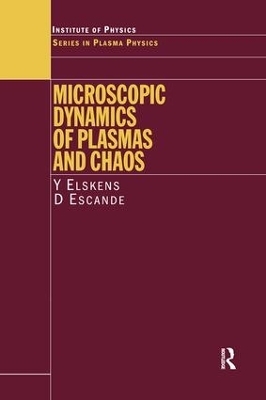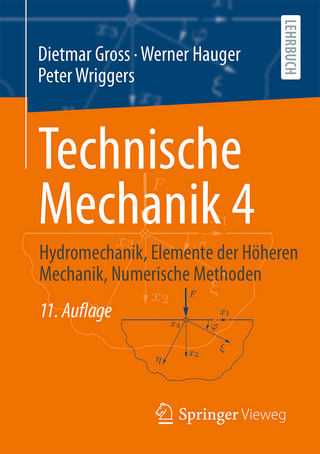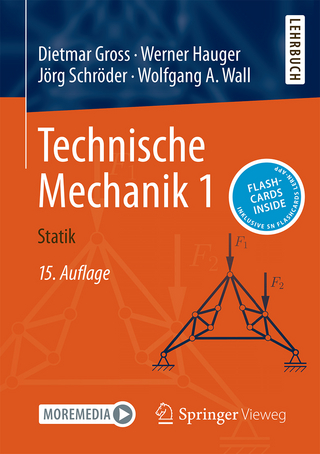
Microscopic Dynamics of Plasmas and Chaos
Institute of Physics Publishing (Verlag)
978-0-7503-0612-6 (ISBN)
- Titel z.Zt. nicht lieferbar
- Versandkostenfrei innerhalb Deutschlands
- Auch auf Rechnung
- Verfügbarkeit in der Filiale vor Ort prüfen
- Artikel merken
Microscopic Dynamics of Plasmas and Chaos discusses the resonant wave-particle interaction in plasmas, provides the tools for chaotic Hamiltonian dynamics, and describes a turbulent macroscopic system through the chaotic classical mechanics of the corresponding N-body problem. The book begins with the fundamentals of N-body dynamics, followed by a statistical description of wave-particle interactions. It then builds up knowledge by examining advanced material that includes Hamiltonian chaos, chaotic diffusion, self-consistent dynamics in the diffusive regime, as well as temporal evolution of a single-wave particle system. The authors describe the subject matter in a systematic and lucid way, supported by detailed simulations.
Dominique Escande, Yves Elskens
Permissions, Preface, Difficulties in the traditional approach, Benefits of modern tools, Structure of the book, Prerequisites and remarks, 1 Basic physical setting, 1.1 The original N-body system, 1.1.1 Physical context, 1.1.2 The plasma model, 1.2 Wave–particle resonance: a paradigm of classical mechanics, 2 From N-body dynamics to wave–particle interaction, 2.1 Intuitive derivation of the self-consistent Hamiltonian, 2.2 Langmuir waves without resonant particles, 2.2.1 Decomposition of the field and particle motion—relevant small parameters, 2.2.2 Collective dynamics, 2.2.3 Bohm–Gross modes, 2.3 Coupled motion of quasi-resonant particles with Bohm–Gross modes, 2.4 Lagrangian formulation*, 2.5 Reference states of the plasma*, 2.5.1 Non-existence of zero-field states, 2.5.2 Thermal distribution of the electric field, 2.6 Physical scalings and error estimates*, 2.7 Final form of the Hamiltonian, 2.8 Historical background and notes, 3 Dynamics of the small-amplitude wave–particle system, 3.1 Reference state with a vanishing electric field, 3.2 Small perturbation to the reference state, 3.3 Ballistic solutions, 3.4 Wavelike solutions, 3.5 Initial value problem, 3.6 Dispersion relation for wavelike modes, 3.7 Physical interpretation: cold beams, 3.7.1 Case of a single beam, 3.7.2 Case of two beams, 3.8 Many cold beams or a warm beam, 3.8.1 Landau unstable mode, 3.8.2 Eigenmodes and initial value problem, 3.8.3 Van Kampen modes*, 3.8.4 Relation with ballistic eigenmodes, 3.8.5 Transition from cold to warm beams, 3.9 Synchronization of particles with a wave, 3.9.1 Synchronization of particles with a wavelike mode, 3.9.2 Synchronization of particles during Landau damping*, 3.9.3 Fate of particles in the presence of many incoherent modes, 3.10 Historical background, 4 Statistical description of the small-amplitude wave–particle dynamics, 4.1 Approach using perturbation expansion, 4.1.1 Second-order perturbation analysis, 4.1.2 Evolution of waves, 4.1.3 Evolution of particles, 4.1.4 Fokker–Planck equation for the particles, 4.2 Approach using Floquet equation*, 4.3 Link with traditional descriptions, 4.3.1 Landau effect from a Vlasovian point of view, 4.3.2 Spontaneous emission, 5 Hamiltonian chaos, 5.1 Geometrical tools for Hamiltonian chaos, 5.1.1 Poincare surface of section, 5.1.2 Conservation of areas, symplectic dynamics and flux*, 5.1.3 Action-angle variables, 5.2 Motion of one particle in the presence of two waves, 5.2.1 Small resonance overlap and cantori, 5.2.2 Moderate resonance overlap and stochastic layers, 5.2.3 Physical summary, 5.3 Construction of orbits, 5.3.1 Origin of higher-order resonances, 5.3.2 Poincare and KAM theorems*, 5.3.3 Higher-order resonances from action-angle, 5.4 Renormalization for KAM tori, 5.4.1 Simple approach to renormalization, 5.4.2 More explicit derivation*, 5.4.3 Study of the renormalization mapping, 5.4.4 Thresholds and exponents, 5.5 Order in chaos, 5.5.1 Wiggling arms of the X-point, 5.5.2 Large resonance overlap: numerical results, 5.5.3 Large resonance overlap: analytical results*, 5.6 Historical background and further comments, 6 Diffusion: the case of the non-self-consistent dynamics, 6.1 Model Hamiltonian, 6.2 Diffusion as a numerical fact, 6.3 Concept of resonance box, 6.3.1 Heuristic analytical approach, 6.3.2 Numerical check of the concept, 6.3.3 Rigorous approach*, 6.4 Scaling properties of finite-time dynamics, 6.5 Origin of the force decorrelation, 6.5.1 Locality and resonance boxes for random, 6.5.2 Correlated phases, 6.5.3 Random initial positions, 6.6 Origin of the chaotic diffusion, 6.7 Locality and diffusion for more general Hamiltonians, 6.8 Initial quasilinear diffusion, 6.8.1 Non-chaotic quasilinear diffusion, 6.8.2 Initial quasilinear diffusion up to chaos, 6.9 Diffusion coefficient in the chaotic regime, 6.10 Drag coefficient, 6.11 Fokker–Planck equation, 6.12 Historical background, 7 Self-consistent dynamics in the diffusive regime, 7.1 Quasilinear diffusion coefficient, 7.2 Simple derivation of the quasilinear equations, 7.3 Evolution of waves*, 7.4 Drag on particles*, 7.5 Joint evolution of particles and waves, 7.6 Saturation of the weak-warm-beam instability, 7.7 Historical background and further comments, 8 Time evolution of the single-wave–particle system, 8.1 Self-consistent nonlinear regime with a single wave, 8.1.1 Instability saturation, 8.1.2 Nonlinear regime of wave damping, 8.2 Unstable beam–wave system, 8.2.1 Cold-beam–wave instability, 8.2.2 Landau instability, 8.2.3 Comparison with the Vlasov-wave description, 8.3 Linear and nonlinear wave damping, 8.3.1 Evolution of the wave intensity, 8.3.2 Finite-N effects competing with Landau damping, 8.4 Historical background and further comments, 9 Gibbsian equilibrium of the single-wave–particle system*, 9.1 Gibbs microcanonical and canonical ensembles, 9.2 Partition function, 9.2.1 Thermodynamic discussion, 9.2.2 Weight function, 9.3 High-temperature phase, 9.3.1 Thermodynamics and wave intensity, 9.3.2 Particle distribution and joint probabilities, 9.4 Low-temperature phase, 9.4.1 Thermodynamics and wave intensity, 9.4.2 Particle distribution and joint probabilities, 9.5 Phase diagrams, 9.6 Bernstein–Greene–Kruskal state, 9.7 Comparison with numerical simulations, 9.8 Further comments, 10 Conclusion, 10.1 Summary, 10.2 Open issues, A Continuous and discrete Fourier transforms, A.1 Perturbed lattices and discrete Fourier transforms, A.2 Representation of trigonometric functions, A.3 Laplace and Fourier transforms, B Special functions, B.1 Euler gamma function, B.2 Bessel functions, B.3 Dirac distribution, C Phase space structure and orbits, D Symplectic structure and numerical integration, D.1 Symplectic dynamics*, D.2 Numerical integration schemes, D.3 Symplectic integration of Hamiltonian dynamics, E Probability and stochastic processes, E. 1 General random variables and vectors, E.2 Gaussian distributions, E.3 Fokker–Planck equation, F Estimates for chapter 6, F.1 /n-time correlation function of C (τ) and S(τ), F.2 Estimate of the mean number of visited boxes, F.3 Initial Brownian motion, F.4 Dependence of an orbit on one phase, F. 5 Estimate of non-quasilinear terms, G Vlasovian formulation of wave–plasma dynamics, G.1 Vlasov-wave partial differential system, G.1.1 Formulation, G.1.2 Derivation from N-body dynamics: kinetic limit, G.1.3 Fourier-transformed Vlasov-wave system, G.2 Zero-field solutions and their linear stability, G.2.1 Wavelike modes, G.2.2 Ballistic modes, G.2.3 Complete solution, G.3 Bernstein–Greene–Kruskal modes, G.4 Vlasov–Poisson system, References, Index
| Erscheint lt. Verlag | 23.10.2002 |
|---|---|
| Reihe/Serie | Series in Plasma Physics |
| Verlagsort | London |
| Sprache | englisch |
| Maße | 156 x 234 mm |
| Gewicht | 680 g |
| Themenwelt | Naturwissenschaften ► Physik / Astronomie ► Mechanik |
| Naturwissenschaften ► Physik / Astronomie ► Plasmaphysik | |
| ISBN-10 | 0-7503-0612-2 / 0750306122 |
| ISBN-13 | 978-0-7503-0612-6 / 9780750306126 |
| Zustand | Neuware |
| Informationen gemäß Produktsicherheitsverordnung (GPSR) | |
| Haben Sie eine Frage zum Produkt? |
aus dem Bereich


